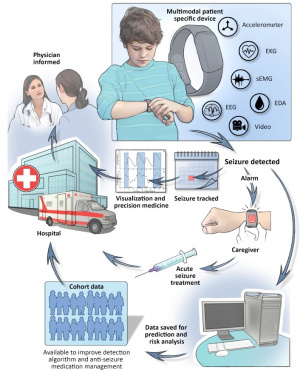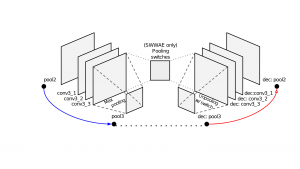Difference between revisions of "Deep Convolutional Autoencoder for iEEG Signals"
From iis-projects
(Created page with "Category:Digital Category:Available Category:Semester Thesis Category:Master Thesis Category:2019Category:HotCategory:Human Intranet File:Non-EE...") |
|||
| (6 intermediate revisions by the same user not shown) | |||
| Line 1: | Line 1: | ||
| − | [[Category:Digital]] | + | [[Category:Digital]][[Category:Semester Thesis]] [[Category:Completed]] [[Category:2020]][[Category:Human Intranet]][[Category:Lukasc]][[Category:xiaywang]][[Category:Herschmi]] |
[[File:Non-EEG Seizure.jpg|thumb|300px]][[File:Deconv.png|thumb|300px]] | [[File:Non-EEG Seizure.jpg|thumb|300px]][[File:Deconv.png|thumb|300px]] | ||
==Description== | ==Description== | ||
| − | Seizure detection systems hold promise for improving the quality of life for patients with epilepsy that afflicts nearly 1% of the world's population. High resolution intracranial Electroencephalography (iEEG) enables the detection and location of such seizures. When aiming a low power implanted system the large amount of data has to be efficiently reduced. iEEG signals are sparse and have been successfully compressed using well established encoders such as Compressive Sensing (CS), Discrete Wavelet Transform (DWT), or Non-Negative Matrix Factorization (NNMF). Due to its recent success, however, convolutional neural nets (CNNs) are getting more attention and showed to be a viable option to compress EEG signals [1]. | + | Seizure detection systems hold promise for improving the quality of life for patients with epilepsy that afflicts nearly 1% of the world's population. High resolution intracranial Electroencephalography (iEEG) enables the detection and location of such seizures. When aiming a low power implanted system the large amount of data has to be efficiently reduced. iEEG signals are sparse and have been successfully compressed using well established encoders such as Compressive Sensing (CS), Discrete Wavelet Transform (DWT), or Non-Negative Matrix Factorization (NNMF). Due to its recent success, however, convolutional neural nets (CNNs) are getting more attention and showed to be a viable option to compress EEG signals [1,2]. |
In this thesis, the students will develop a deep convolutional autoencoder to compress iEEG signals. | In this thesis, the students will develop a deep convolutional autoencoder to compress iEEG signals. | ||
| − | ===Status: | + | ===Status: Completed === |
| − | : | + | : Simon Hungerbühler |
| − | : Supervision: [[:User:Herschmi | Michael Hersche]], [mailto:abbas@iis.ee.ethz.ch Abbas Rahimi] | + | : Supervision: [[:User:Herschmi | Michael Hersche]], [[:User:xiaywang|Xiaying Wang]], [[:User:lukasc|Lukas Cavigelli]], [mailto:abbas@iis.ee.ethz.ch Abbas Rahimi] |
===Prerequisites=== | ===Prerequisites=== | ||
| Line 56: | Line 56: | ||
===Literature=== | ===Literature=== | ||
* Tingxi Wen et. al., Deep Convolution Neural Network and Autoencoders-Base Unsupervised Feature Learning of EEG Signals [https://ieeexplore.ieee.org/stamp/stamp.jsp?tp=&arnumber=8355473] | * Tingxi Wen et. al., Deep Convolution Neural Network and Autoencoders-Base Unsupervised Feature Learning of EEG Signals [https://ieeexplore.ieee.org/stamp/stamp.jsp?tp=&arnumber=8355473] | ||
| + | * Abeer Z. Al-Marridi et. al., Convolutional Autoencoder Approach for EEG Compression and Reconstruction in m-Health Systems [https://ieeexplore.ieee.org/abstract/document/8450511] | ||
===Practical Details=== | ===Practical Details=== | ||
| Line 100: | Line 101: | ||
---> | ---> | ||
| − | [[Category: | + | [[Category:Herschmi]] |
Latest revision as of 13:36, 9 September 2020
Contents
Description
Seizure detection systems hold promise for improving the quality of life for patients with epilepsy that afflicts nearly 1% of the world's population. High resolution intracranial Electroencephalography (iEEG) enables the detection and location of such seizures. When aiming a low power implanted system the large amount of data has to be efficiently reduced. iEEG signals are sparse and have been successfully compressed using well established encoders such as Compressive Sensing (CS), Discrete Wavelet Transform (DWT), or Non-Negative Matrix Factorization (NNMF). Due to its recent success, however, convolutional neural nets (CNNs) are getting more attention and showed to be a viable option to compress EEG signals [1,2].
In this thesis, the students will develop a deep convolutional autoencoder to compress iEEG signals.
Status: Completed
- Simon Hungerbühler
- Supervision: Michael Hersche, Xiaying Wang, Lukas Cavigelli, Abbas Rahimi
Prerequisites
- Machine Learning
- Linear Algebra
- Python Programming
Character
- 20% Theory
- 80% Programming
Professor
Literature
- Tingxi Wen et. al., Deep Convolution Neural Network and Autoencoders-Base Unsupervised Feature Learning of EEG Signals [1]
- Abeer Z. Al-Marridi et. al., Convolutional Autoencoder Approach for EEG Compression and Reconstruction in m-Health Systems [2]

